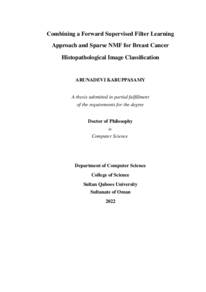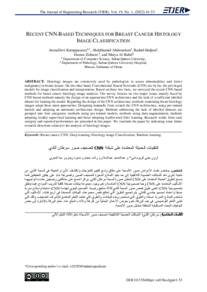وثيقة
Combining a forward supervised filter learning approach and sparse NMF for breast cancer histopathological image classification.
عناوين أخرى
الجمع بين نهج التعلم المرشح الخاضع للإشراف إلى الأمام و NMF المتناثر لتصنيف الصور النسيجية لسرطان الثدي
الناشر
Sultan Qaboos University.
ميلادي
2022
اللغة
الأنجليزية
الموضوع
الملخص الإنجليزي
Breast Cancer is the most common cancer among women worldwide. In Oman,
one out of five Omani women was diagnosed with breast cancer in her lifetime as indicated by the National Cancer Registry. Histopathological images are essential re sources for clinical observation to diagnose the presence or the extent of abnormal con ditions. These images are usually large and complex which make the diagnosis process tedious, time-consuming, and prone to errors. Hence, there is a need for automat ing the histopathological image analysis process. Early machine learning methods for
histopathological image processing rely on hand-crafted features extracted from these
images with the help of domain knowledge experts. The recent Deep Learning (DL)
models (such as Convolutional Neural Network (CNN)) are capable of extracting au tomatically, from the raw data, features of different levels of abstraction and use them
to accomplish successfully complex computer vision tasks. Traditional CNNs like
AlexNet,etc use the back-propagation algorithm for learning the filters during the train ing phase. Such an algorithm requires a huge amount of labeled datasets which leads
to high computational processing. Moreover, it may encounter the vanishing gradient
problem that deteriorates the quality of learning. Besides, in many domains, acquiring
enough labeled images for conducting properly the training phase is a real challenge.
The forward supervised filter learning approach was proposed to tackle these problems.
On the other hand, Non-Negative Matrix Factorization (NMF) decomposes input data
into two latent factors. It has been shown that by enforcing constraints such as sparsity
on the latent factors, dominant features that are mostly correlated with tumors types can
be extracted. This research focuses on the development of a novel model that learns
useful representations from histopathological images for the purpose of their classi fication. We have derived a mathematical model of a novel forward supervised filter
learning approach that combines sparse NMF and Support Vector Machine technique.
The model is used to design and implement a feed-forward CNN classifier (CSNMF SVM) to classify histopathology images. Moreover, we modified the architecture of an
existing feed-forward CNN (CSVM), to classify histopathological images. We named
the model, Convolutional Support Vector Machine for Histopathology (CSVM-H). Fi nally, we have modified the loss function used by CSVM-H (replaced the hinge loss
by the binary cross entropy) to obtain a classification model, we named Convolutional
Logistic Regression for Histopathology (CLR-H). All these models have been eval uated on the histopathology images from Sultan Qaboos University Hospital dataset and the publically available BreaKHis dataset. The experiments we have conducted
demonstrate the efficiency of the proposed models, especially on small-sized datasets.
المجموعة
URL المصدر
الملخص العربي
يعد سرطان الثدي أكثر أنواع السرطانات شيوعا بين النساء في جميع أنحاء العالم. في ُعمان ، تم تشخيص إصابة واحدة من كل خمس نساء عمانيات بسرطان الثدي في حياتها وفقًا لسجل السرطان الوطني. حيث تعتبر الصور النسيجية
المرضية هي مصادر أساسية للمراقبة السريرية لتشخيص الحالات غير الطبيعية ومداها. عادة ما تكون هذه الصور
كبيرة ومعقدة مما يجعل عملية التشخيص مملة وتستغرق وقتًا طويلً وعرضة لألخطاء. لذا، هناك حاجة ألداء عملية
تحليل الصور النسيجية المرضية. يعتمد هذا التحليل على أساليب التعلم الآلي المبتكرة لمعالجة الصور النسيجية
المرضية باالعتماد على ميزات محددة يدويًا مستخرجة من هذه الصور بمساعدة خبراء في هذا المجال. نماذج التعلم
قادرة على االستخراج تلقائيًا من البيانات األولية ((CNN (مثل الشبكة العصبية التلفيفية) الحديثة (DL (العميق
CNN وكذلك استخراج ميزات مستويات مختلفة من التجريد واستخدامها إلنجاز المهام المعقدة بنجاح. تستخدم شبكات
، إلخ ، خوارزمية الانتشار العكسي لتعلم المرشحات أثناء مرحلة التدريب. تتطلب مثل هذه AlexNet التقليدية مثل
الخوارزمية قد ًرا هائلً من مجموعات البيانات ذات العلمات التي تؤدي إلى معالجة حسابية عالية. علوة على ذلك ،
قد يواجه مشكلة التدرج المتلاشي التي تؤدي إلى تدهور جودة التعلم، في العديد من المجالات ، ويعد الحصول على
صور معنونة كافية إلجراء مرحلة التدريب بشكل صحيح تحديًا حقيقيًا. تم اقتراح نهج تعلم المرشح الخاضع للإشراف
بيانات اإلدخال (NMF (لمعالجة هذه المشكلات. من ناحية أخرى ، يحلل النهج المقترح عامل المصفوفة غير السلبي
إلى عاملين كامنين. ولقد ثبت أنه من خلل فرض قيود مثل التباين على العوامل الكامنة ، يمكن استخراج السمات
المهيمنة التي ترتبط في الغالب بأنواع الأورام .
يركز هذا البحث على تطوير نموذج جديد يتعلم التمثيلات المفيدة من الصور النسيجية المرضية لغرض تصنيفها. لقد اشتققنا نموذ ًجا رياضيًا لنهج جديد لتعلم المرشح تحت الإشراف الأمامي يستخدم النموذج لتصميم وتنفيذ .Machine Vector Support المتناثرة وتقنية دعم NMF والذي يجمع بين تقنية لتصنيف صور التشريح المرضي. علوة على ذلك ، قمنا بتعديل بنية شبكة (SVM-CSNMF (CNN مصنف الحالية للتغذية إلى األمام ، لتصنيف الصور النسيجية المرضية. وقمنا بتسمية النموذج ، آلة ناقلت (CSVM (CNN
استبدلنا خسارة المفصلة بالانتروبيا الثنائية المتقاطعة( للحصول على نموذج تصنيف ، أطلقنا عليه اسم الانحدار ) H CSVM أخيًرا ، قمنا بتعديل وظيفة الخسارة التي يستخدمها .(H-CSVM (الدعم التلفيفي لعلم التشريح المرضي تم تقييم كل هذه النماذج على صور التشريح المرضي من مجموعة .(H-CLR (اللوجستي التلفيفي لعلم الأنسجة المتاحة للجمهور. توضح التجارب التي BreaKHis بيانات مستشفى جامعة السلطان قابوس ومجموعة بيانات .أجريناها كفاءة النماذج المقترحة ، خاصة على مجموعات البيانات الصغيرة الحجم
المرضية هي مصادر أساسية للمراقبة السريرية لتشخيص الحالات غير الطبيعية ومداها. عادة ما تكون هذه الصور
كبيرة ومعقدة مما يجعل عملية التشخيص مملة وتستغرق وقتًا طويلً وعرضة لألخطاء. لذا، هناك حاجة ألداء عملية
تحليل الصور النسيجية المرضية. يعتمد هذا التحليل على أساليب التعلم الآلي المبتكرة لمعالجة الصور النسيجية
المرضية باالعتماد على ميزات محددة يدويًا مستخرجة من هذه الصور بمساعدة خبراء في هذا المجال. نماذج التعلم
قادرة على االستخراج تلقائيًا من البيانات األولية ((CNN (مثل الشبكة العصبية التلفيفية) الحديثة (DL (العميق
CNN وكذلك استخراج ميزات مستويات مختلفة من التجريد واستخدامها إلنجاز المهام المعقدة بنجاح. تستخدم شبكات
، إلخ ، خوارزمية الانتشار العكسي لتعلم المرشحات أثناء مرحلة التدريب. تتطلب مثل هذه AlexNet التقليدية مثل
الخوارزمية قد ًرا هائلً من مجموعات البيانات ذات العلمات التي تؤدي إلى معالجة حسابية عالية. علوة على ذلك ،
قد يواجه مشكلة التدرج المتلاشي التي تؤدي إلى تدهور جودة التعلم، في العديد من المجالات ، ويعد الحصول على
صور معنونة كافية إلجراء مرحلة التدريب بشكل صحيح تحديًا حقيقيًا. تم اقتراح نهج تعلم المرشح الخاضع للإشراف
بيانات اإلدخال (NMF (لمعالجة هذه المشكلات. من ناحية أخرى ، يحلل النهج المقترح عامل المصفوفة غير السلبي
إلى عاملين كامنين. ولقد ثبت أنه من خلل فرض قيود مثل التباين على العوامل الكامنة ، يمكن استخراج السمات
المهيمنة التي ترتبط في الغالب بأنواع الأورام .
يركز هذا البحث على تطوير نموذج جديد يتعلم التمثيلات المفيدة من الصور النسيجية المرضية لغرض تصنيفها. لقد اشتققنا نموذ ًجا رياضيًا لنهج جديد لتعلم المرشح تحت الإشراف الأمامي يستخدم النموذج لتصميم وتنفيذ .Machine Vector Support المتناثرة وتقنية دعم NMF والذي يجمع بين تقنية لتصنيف صور التشريح المرضي. علوة على ذلك ، قمنا بتعديل بنية شبكة (SVM-CSNMF (CNN مصنف الحالية للتغذية إلى األمام ، لتصنيف الصور النسيجية المرضية. وقمنا بتسمية النموذج ، آلة ناقلت (CSVM (CNN
استبدلنا خسارة المفصلة بالانتروبيا الثنائية المتقاطعة( للحصول على نموذج تصنيف ، أطلقنا عليه اسم الانحدار ) H CSVM أخيًرا ، قمنا بتعديل وظيفة الخسارة التي يستخدمها .(H-CSVM (الدعم التلفيفي لعلم التشريح المرضي تم تقييم كل هذه النماذج على صور التشريح المرضي من مجموعة .(H-CLR (اللوجستي التلفيفي لعلم الأنسجة المتاحة للجمهور. توضح التجارب التي BreaKHis بيانات مستشفى جامعة السلطان قابوس ومجموعة بيانات .أجريناها كفاءة النماذج المقترحة ، خاصة على مجموعات البيانات الصغيرة الحجم
قالب العنصر
الرسائل والأطروحات الجامعية


